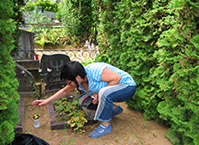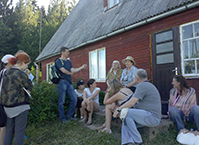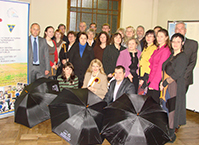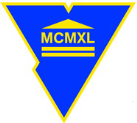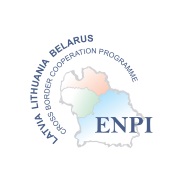E-MUSEUM “VITAMEMORIAE”: COLLECTION AND RESEARCH
Foto
To record people’s life stories, traditions, customs, rituals, rare photographs, old documents, ethnographic differences in funeral rites, etc. the researchers of Daugavpils University and Yanka Kupala Grodno State University carried out field studies in LV and BY territories: in the villages of Krāslava, Rēzekne, Daugavpils regions (Asūne, Foļvarka, Kruki, Skrudaliena, Indra, etc.) and in Belarus (Braslav and Vitebsk districts). The field studies were implemented in the framework of the project “Popularization of the Centres of Oral History in the LV – BY Cross-Border Area”, ID Nr. LLB–2–143, of the Cross Border Cooperation Programme Latvia–Lithuania–Belarus implemented within the framework of the European Neighbourhood and Partnership Instrument 2007–2013.
During the research and the expeditions, the project implementers collected, segmented, transcribed, and digitized the audio-visual materials (audio and video records, photo evidence). To make the collection of the E-Museum more complete, the field researchers and cemetery researchers of Daugavpils University and Grodno University will segment and systematize the audio-visual materials collected during oral history, cemetery research, folklore and dialectology expeditions of the previous years that until now have not been used, aiming at including the best and most valuable segments of the collection into the E-Museum.
The story tellers whose life stories make the input of the E-Museum are people of various generations, mostly elderly people. The childhood of aged people, who at present are about 80 years old, proceeded in the 1930s, therefore the segmented audio-visual units included in the E-Museum chronologically begin from 1929 and can describe only the respondents’ childhood memories. The memory of the older generation is particularly important for the anthropological and historical research – it shifts the time borders, allows for moving to the events of the past through the viewpoints of those who have experienced those times. The facts can be found in chronicles, but what the witnesses of that time can reveal give the memories colour, scent, involve one into mutual emotional experience. The witnesses of the epoch tell about the events form the viewpoint of their own experience.
To motivate the respondents to share their life stories, the project field researchers used Paul Thomson’s oral history research method – enlarged vision of social history where diverse groups of the society are brought together and share common historical experience.
The research basis is the methodology of a semi-structured interview that envisages focused (guided) reconstruction of the past events and an interviewer only helps the respondents to reconstruct the past.
The oral history collection of the E-Museum is envisaged to be used not only by specialists but also by a greatest possible range of non-specialists, therefore, departing from the academic tradition envisaging a complete script and transcript (written transcription of an audio or video record) of life stories, the project experts agreed to segment 360 most vivid, colourful, expressive, unusual, typological or extraordinary audio-visual units (photo, video and audio testimonies) – thematically complete excerpts, and to systematize them according to the thematic plan that would encompass both the historical processes of the 20th century (from the 1920s-30s) and the most essential events of an individual’s life.
ACCESSIBILITY OF THE COLLECTION
The interviews included into the collection are arranged according to the principle of historicism, anthropologism and personalia, indicating the author’s name and the interviewer’s name and surname.
-
A person and authorities
So, there started such persecutions, my mother told me that she was dating with a boy from Poland who was implicated in something. So before the very graduation from the institute, we were already …
Researcher: Наталья Иващенко, кандидат исторических наук, ГрГУ им. Я. Купалы, Светлана Силова, кандидат исторических наук, доцент, ГрГУ им. Я. Купалы
Categories: Man and authority, Ira Motolyga
-
Orenburg-Borisov-Moskva
How long did it take you to get from Orenburg to Borisov?
My mother told me it took 14 days. Not to Borisov, but to Moscow. We wanted to stay in Moscow, but they built barracks for the evacuees. …
Researcher: Наталья Иващенко, кандидат исторических наук, ГрГУ им. Я. Купалы, Светлана Силова, кандидат исторических наук, доцент, ГрГУ им. Я. Купалы
Categories: Wartime, Ira Motolyga
-
End of the War
The war finished, I remember that day very well, I don’t know if that was the day war finished or not when the German captives were passing by and my sister Anka took me by the hand and shouted, …
Researcher: Наталья Иващенко, кандидат исторических наук, ГрГУ им. Я. Купалы, Светлана Силова, кандидат исторических наук, доцент, ГрГУ им. Я. Купалы
Categories: End of the war, Ira Motolyga
-
The Germans in Orenburg
And what did the captured Germans do in Orenburg?
They were being led, probably, by the builders or anybody else. They were being led and they were going. And we though, we didn’t know who …
Researcher: Наталья Иващенко, кандидат исторических наук, ГрГУ им. Я. Купалы, Светлана Силова, кандидат исторических наук, доцент, ГрГУ им. Я. Купалы
Categories: Mode of life, Ira Motolyga
-
The beginning of war
We were getting on well. We lived in plenty. We had a very big house. We lived well. Well, once father came and said, «Basya, don’t say anybody a word, there will be a war».
Did he …
Researcher: Наталья Иващенко, кандидат исторических наук, ГрГУ им. Я. Купалы, Светлана Силова, кандидат исторических наук, доцент, ГрГУ им. Я. Купалы
Categories: Beginning of the war, Ira Motolyga
-
Fashion
What was the fashion at the time?
What was the fashion? It wasn’t allowed to come to school without uniform. There appeared lisle and nylon stockings with a black heel, with a contoured heel, …
Researcher: Наталья Иващенко, кандидат исторических наук, ГрГУ им. Я. Купалы, Светлана Силова, кандидат исторических наук, доцент, ГрГУ им. Я. Купалы
Categories: Residence and weekdays, Ira Motolyga
-
Post-war Minsk
You say that you remember Minsk very well. What did it look like when you saw it?
Minsk was in ruins. There were even dugouts in Minsk. And there were a lot of legless people in wheelchairs, and …
Researcher: Наталья Иващенко, кандидат исторических наук, ГрГУ им. Я. Купалы, Светлана Силова, кандидат исторических наук, доцент, ГрГУ им. Я. Купалы
Categories: Residence and weekdays, Ira Motolyga
-
International relations
I didn’t know at all who the Jews are. Once I came home and shouted, «Grandmother, close the door, it’s not true. He offended me, he bawled me out and I bawled him out».
Аnd …
Researcher: Наталья Иващенко, кандидат исторических наук, ГрГУ им. Я. Купалы, Светлана Силова, кандидат исторических наук, доцент, ГрГУ им. Я. Купалы
Categories: Confessional and international relations, Ira Motolyga
-
Family
When «Azot» was being built, my husband built «Azot» and we were directed here.
And you arrived at Grodno for the first time. What were your first impressions?
Small street, …
Researcher: Наталья Иващенко, кандидат исторических наук, ГрГУ им. Я. Купалы, Светлана Силова, кандидат исторических наук, доцент, ГрГУ им. Я. Купалы
Categories: Residence and weekdays, Ira Motolyga
-
Jewish tradition
Just a few spoke at the children’s presence. The elder spoke their own language. I could understand a little, but couldn’t speak. I have one sister, she says, «Speak Russian, or …
Researcher: Наталья Иващенко, кандидат исторических наук, ГрГУ им. Я. Купалы, Светлана Силова, кандидат исторических наук, доцент, ГрГУ им. Я. Купалы
Categories: Family, Ira Motolyga


